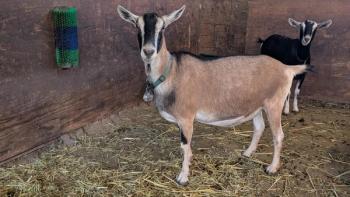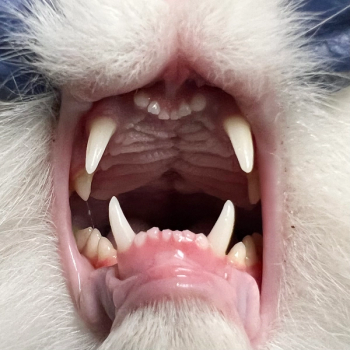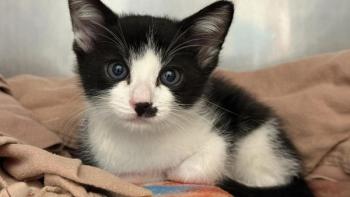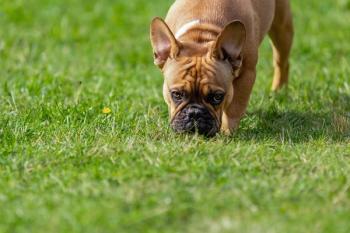
- dvm360 September 2024
- Volume 55
- Issue 9
- Pages: 25
Surgical management of advanced mammary disease in ruminants
Mastectomy can provide relief in certain cases for patients with painful conditions
Mammary disease commonly afflicts small ruminants and cattle. In some cases, the mammary glands can be extensively enlarged and painful (Figure 1a). Such considerable disease results from mastitis, cancer, or precocious mammary gland development. Mastitis, including chronic bacterial infection with abscessation or rapidly progressive gangrenous disease, can be unilateral or bilateral. Although medical management is the first line of treatment for mastitis, the removal of glands with deeply seated infection or of those contributing massive toxin output can be indicated. Similarly, cancer can be isolated to a single quarter or half of the udder or distributed throughout the udder. Adenocarcinoma, adenoma, sarcoma, and squamous cell carcinoma are reported to affect ruminant mammaries.1,2 Chronic mastitis and cancer can cause marked mammary enlargement, as well as secondary infection with draining tracts and systemic debilitation including weight loss and anemia.1
Precocious mammary development with associated lactation is rarely reported in cattle but is commonly observed in goats as a generalized condition of the mammary glands.2-4 The underlying cause of nulliparous with developing spontaneous lactation is not well understood; however, it is likely associated with a genetic predisposition to voluminous milk production and possibly dysregulation of prolactin secretion from the pituitary gland, especially during springtime.5 Other causes of precocious mammary development include a persistent corpus luteum (CL), ovarian neoplasia, and zearalenone toxicosis.3 Milking the udder contributes to further milk production and mastitis. Instead, milking should be avoided or ceased in the autumn to dry the udder, and the ovaries should be evaluated for abnormalities.5 Treatment with prostaglandin can cause luteolysis and regression of a persistent CL, thereby preventing further udder enlargement. Regardless of the cause of mammary enlargement, the udder should be monitored for signs of trauma and secondary infection.
Relief from these painful conditions can be provided by mastectomy (Figure 1b). The pattern of surgical skin incision varies based on clinician preference, the need for a unilateral or bilateral mastectomy, and the presence of ulcerated skin or draining tracts. The goal of a cloverleaf or elliptical incision (Figure 2a) is to adequately preserve skin for a tension-free closure and facilitate management of dead space.4,6 Complication rates between these 2 incisional approaches do not vary.4 The surgical procedure requires extensive subcutaneous dissection to isolate the mammary gland. Dissection is difficult when the gland is adhered to the skin and when the weight of the udder impairs manipulation of the tissue. These factors could increase the potential for inadvertent contamination of the surgical site with fluid from the mammary gland. Thorough lavage is helpful to decontaminate the surgical site prior to closure. When cancer or infection are the impetus for surgery, peripheral lymph nodes should also be excised, and histopathology performed on lymph node and mammary tissue.4
Ligation of several large vessels is imperative to prevent fatal hemorrhage. These include the external pudendal arteries and veins (Figure 2b), the ventral perineal arteries, and the subcutaneous abdominal veins.2 Careful hemostasis throughout the procedure likely decreases postoperative swelling by preventing hematoma or seroma formation. Monopolar cautery and a bipolar vessel sealing device are valuable to speed the surgical approach. In cows, the surgical procedure can be hastened by having 2 teams of surgeons working simultaneously.2 Penrose drain placement at closure is a common means of managing dead space from the excised mammary gland (Figure 2c) and the drain(s) will commonly remain in place for 2 to 3 days to prevent seroma formation.4 Skin closure is often in an X or Y shape, although sometimes a linear closure is functional (Figure 3a and Figure 3b). Skin tension during closure is common and can be decreased by placing walking sutures in the subcutaneous tissue and using tension-relieving suture patterns in the skin and a stent bandage over the incision. The postoperative period can be marked by acute pain that can be preemptively managed by epidural and transdermal fentanyl administration preoperatively to limit the need for rescue analgesia.7 Postoperative care includes several weeks of stall confinement and restricted exercise, along with perioperative antibiotics.
Total mastectomy in cattle requires an extended period under general anesthesia in dorsal recumbency during which time the patient can encounter significant anesthetic morbidity, especially when simultaneous blood loss occurs. Anemia of chronic disease is often identified in this population preoperatively, creating a low threshold for blood loss. Transfusion under general anesthesia can be beneficial for blood replacement to maintain the patient’s oxygenation and blood pressure.
Another significant consideration in cattle is the necessity of total mastectomy over single-quarter or unilateral mastectomy depending on the focal or distributed nature of disease (Figure 4).8,9 Lateral recumbency and a shorter surgical time are advantages of unilateral or single-quarter mastectomy over total mastectomy, likely lessening the risk of anesthetic-related morbidity for the patient. An additional alternative for systemically ill animals is a standing mastatrophy procedure with a paralumbar fossa surgical approach.10 The goal of the procedure is intra-abdominal ligation of the external pudendal arteries and veins, thereby minimizing endotoxin release from the glands affected by gangrenous mastitis. Although the surgery has little systemic morbidity, it precipitates gland atrophy and tissue sloughing that can result in the need for extensive wound care. A similar procedure by a transcutaneous inguinal approach can be performed; however, it does not eliminate the need for anesthesia.11
Behavior changes, including aggression and male sexual behavior, have been reportedly associated with hormonal imbalance caused by total mastectomy.4 In some cases, ovariectomy or ovariohysterectomy have been performed simultaneously with the goal of offsetting the behavioral impact of mastectomy. Regardless of postoperative behavior changes, owners report a high level of satisfaction with the outcome of mastectomy.4
Overall survival outcomes for mastectomy in ruminants are good and can prolong the life of an animal, particularly when the animal is healthy and has severe mammary gland disease.2,4 The patient’s condition postoperatively is generally marked by improvements to ambulation and systemic health, including superior attitude and appetite.
References
- Krus CB, Mullins C, Oman R. Goats diagnosed with neoplasia display variability in clinical presentations, treatments, and outcomes. J Am Vet Med Assoc. 2023;261(5):661-667. doi:10.2460/javma.22.11.0530
- Cable CS, Peery K, Fubini SL. Radical mastectomy in 20 ruminants. Vet Surg. 2004;33(3):263-266. doi:10.1111/j.1532-950x.2004.04038.x
- Ambrose DJ, Emmanuel DGV. Precocious mammary development in an 8-month-old Holstein heifer. Can Vet J. 2008;49:803-805. doi:10.7939/r3mw28t64
- Hermida JA, Baird AN, Hawkins JF, Moore GE. Mastectomy in 25 small ruminants (2002-2019). Vet Surg. 2021;50(1):104-110. doi:10.1111/vsu.13509
- Smith MC, Sherman DM. Goat Medicine. 3rd ed. Wiley-Blackwell; 2022.
- Baird AN. Small ruminant surgery. In: Hendrickson DA, Baird AN, eds. Turner and Mcllwraith’s Techniques in Large Animal Surgery. 4th ed. Wiley-Blackwell; 2013: 297-299.
- Daradka M, Ismail ZB. Evaluation of the clinical and analgesic effects of subarachnoid ketamine-lidocaine administration in goats undergoing mastectomy. Vet Med (Auckl). 2014;5:35-39. doi:10.2147/vmrr.s59609
- Ortega-Pacheco A, Aguilar-Caballero AJ, Jimenez-Coello M, Tzab R, Gutierrez- Blanco E. Total mastectomy in a cow with gangrenous mastitis. Vet Rec Case Rep. 2017;4(2):e000333. doi:10.1136/vetreccr-2016-000333
- Phiri AM, Muleya W, Mwape KE. Management of chronic gangrenous mastitis in a 3-year-old cow using partial (quarter) mastectomy. Trop Anim Health Prod. 2010;42(6):1057-1061. doi:10.1007/s11250-010-9541-2
- Allen AJ, Barrington GM, Parish SM. Physiologic mastectomy via flank laparotomy. Vet Clin North Am Food Anim Pract. 2008;24(3):511-516. doi:10.1016/j. cvfa.2008.06.006
- Brewer RL. Mammary vessel ligation for gangrenous mastitis. J Am Vet Med Assoc. 1963;143:44-45.
Articles in this issue
about 1 year ago
What’s in a name?about 1 year ago
Clearing the air in contaminated spacesabout 1 year ago
Compassionate conversations when scheduling euthanasiaabout 1 year ago
How to create an attendance policyabout 1 year ago
Identifying and treating canine and feline urolithiasisabout 1 year ago
Dentistry A to Z: G is for geneticsabout 1 year ago
The amazing POTUS — pets of the United States!about 1 year ago
Hands-on labs aim to build skills for Fetch Coastal attendeesabout 1 year ago
Peticaid: An idea whose time has comeNewsletter
From exam room tips to practice management insights, get trusted veterinary news delivered straight to your inbox—subscribe to dvm360.






